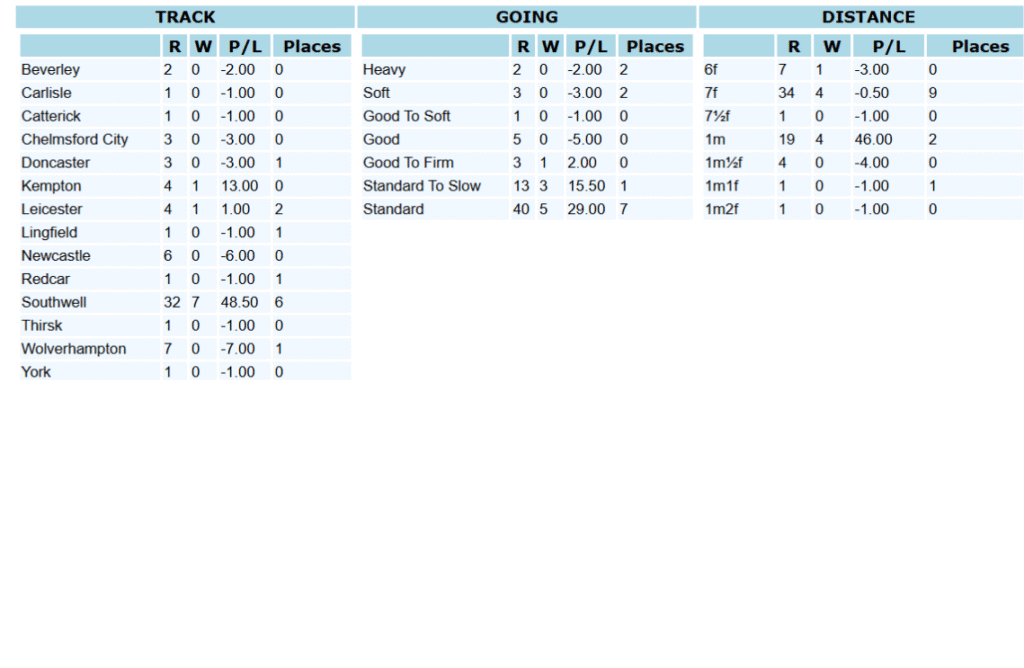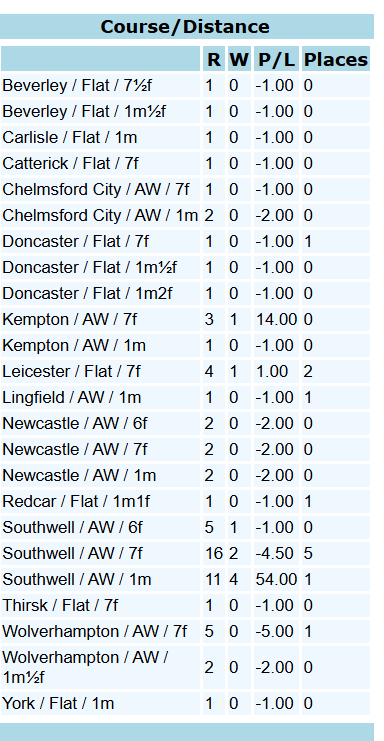Race Horse Profiling - How To Profile A Race Horse
Understanding how to profile a race horse is one of the most valuable skills any serious bettor can develop. While many punters rely on tips or form summaries, true insight comes from learning how to build a full race horse profile based on track preferences, running style, trainer patterns, and surface suitability. This guide breaks down the core components of effective race horse profiling so you can make better betting decisions and develop your own edge in the market. Whether you’re interested in flat turf racing, all-weather handicaps, or novice contests, learning how to analyse a horse’s profile will help you avoid false favourites and identify overlooked value. From trip suitability to seasonal patterns, this step-by-step approach to profiling race horses is written for those who want to understand the game properly — not just follow the market.
What Is Horse Profiling and Why It Matters in Handicap Racing
Horse profiling is the process of building a detailed picture of a race horse’s preferences, characteristics, and behavioural traits based on its past performances. This includes factors like ideal trip, surface, track configuration, pace preference, seasonal patterns, and response to headgear or field size. A race horse profile isn’t just about form figures — it’s about identifying the conditions under which a horse runs to its potential and, more importantly, when it doesn’t.
Profiling matters because not all horses are straightforward — especially in lower-grade handicap racing. Unlike top-class performers where form, ability, and intent are often laid bare for all to see, Class 5 and Class 6 handicappers often carry quirks, patterns, or preferences that slip beneath the radar. These horses aren’t covered in depth by major racing outlets. You won’t find a two-page spread on a Wolverhampton Class 6 runner in the Racing Post — yet these are the horses where sharp profiling can uncover value the market hasn’t fully priced in.
In the world of low-grade handicaps, profiling a race horse gives you a tactical edge. It helps you understand not only when a horse is likely to run well, but also why it’s likely to underperform — allowing you to bet for or against it with greater confidence.
Example: Profiling a Real Horse – Al Suil Eile
To bring everything we’ve covered so far into sharp focus, I’m now going to walk you through a full real-world example using a horse called Al Suil Eile. This isn’t just theory — this is exactly how I assess a horse’s profile when analysing a race.
Al Suil Eile is a seasoned handicapper who’s been active across various distances and surfaces in the lower-grade racing scene. That makes him the ideal example for this guide — not because he’s a superstar, but because his career offers exactly the kind of depth, variance, and profile traits that new bettors need to learn how to read.
Over the next few steps, I’ll break down:
Where to start when assessing a horse’s profile
How to spot patterns in form, suitability, and surface/trip preferences
What performance ratings really mean in the context of class and OR
Why context is king – and how a horse’s record only makes sense when you understand the setups behind it
Each section will include short explanations and screenshots so you can follow the logic visually. The goal is to help you think critically and build your own system for assessing any horse — not just copying tips, but understanding why a profile points to suitability, strength, or risk.
So as you can see from the screenshot from Racing Post, Al Suil Eile is very exposed and has raced many times. But even when you’re just looking at the last couple of seasons, a lot of people still dismiss a horse like this purely based on the recent form figures — and that’s common.
The problem is, by doing that, you can easily miss patterns or angles that actually show the horse still has conditions where it can be competitive.

So if we look, we can see the horse has had 8 wins and a decent number of placings on the All-Weather surface from 53 runs. On the face of it, that doesn’t look great — and again, plenty of people would stop there.
But what it does give us is a way in. That kind of volume gives us enough data to start breaking things down properly and seeing if there’s a genuine profile underneath.
I use software for this but below you will the horses track stats and distance stats

You can clearly see a strong track preference for Southwell on the All-Weather surface — 32 races there, with 7 wins and 6 places. All the other tracks show very little in comparison.
Looking at distance, there’s also a clear pattern:
7f: 4 wins and 9 places
1m: 4 wins and 2 places
Now, sure — you could argue that Al Suil Eile races at Southwell the most, so of course the record looks better there. But that’s missing the point.
The real question is why this horse keeps going back to Southwell, and why the record at other tracks — even though there are fewer runs — is so poor. Same with distance: is it just chance, or does something in his profile make 7f–1m, particularly at Southwell, the sweet spot?
This is where we start to build a real picture.

We could make a case for both distances based on the raw numbers — 7f and 1m have both produced wins. But what’s interesting is that the horse has changed yards, and it looks like the new stable has found the key: 1 mile.
That shift matters. When a horse with loads of past runs suddenly starts running more efficiently or consistently under a new yard, especially when aligned to a specific trip, it’s usually not a coincidence — it’s a clue.
So now we’re not just looking at past distance stats — we’re starting to profile where the horse is currently most effective, not just historically spread.

So I took the liberty of looking through all of his runs — and the pattern doesn’t just stop at track or trip. It repeats at 1 mile specifically when the horse runs off an Official Rating of 60 or lower.
At 1m at Southwell, when rated 60 or below, the form reads: 1-1-3-1.
Now, if you were seeing that as a base form line, you wouldn’t expect SPs of 15/1, 23/1, 19/1, and 12/1 — but that’s the reality. This is exactly where the horse excels as a handicapper and where its competitive ceiling lies.
Yes, we might miss the odd one — for example, when he won off 63 — but the point is we’re not trying to cherry-pick. We’re looking at the profile as a whole and understanding where the horse is consistently competitive, not just where it happened to pop up once.
Why Profiling Low-Grade Handicappers Can Give You a Big Edge
Hopefully by now you can see that profiling a low-grade handicapper properly can be very insightful — and it gives you an edge where others often miss.
You have to remember: these are low-grade horses, yes — but they still need to be winning or placing to justify their place in training. Owners have bills to pay, and once a yard finds the key to a horse, they’ll usually stick to those conditions going forward.
The important part is timing. After a win, the official rating will go up — so we often have to wait for a few runs where the horse is just getting back into the right mark zone. But if you’re disciplined and patient, it can really pay off.
These horses aren’t going to win — or even run well — every single time they hit the right profile. But in general, the yards do aim them at the right setups when the horse is fit and ready. That’s where profiling makes the difference — you’re thinking like a trainer, not just reacting to numbers on a page.
Staying Updated with Profiled Horses
We do follow a number of profiled horses like Al Suil Eile, but we don’t maintain a live list on the website. The reason’s simple — these types of horses often change yards, lose form, or age out of their competitive window, and we don’t want to risk misleading anyone by publishing outdated or incomplete info.
That said, we do regularly share updates, insights, and profiled angles through our Facebook groups and pages, which are much easier to manage in real-time. So if you’re interested in staying on top of these kinds of horses — the ones that fit clear, repeatable conditions — it’s definitely worth checking those out.
.















